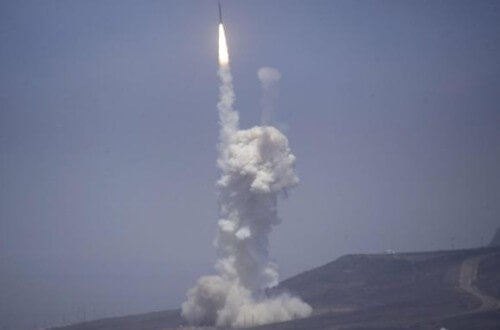Ricochet is the best place on the internet to discuss the issues of the day, either through commenting on posts or writing your own for our active and dynamic community in a fully moderated environment. In addition, the Ricochet Audio Network offers over 50 original podcasts with new episodes released every day.
 Missile Defense: Fourth Time’s the Charm (Updated With Video)
Missile Defense: Fourth Time’s the Charm (Updated With Video)
 Update: See comments 18 and 19 for video. After failing in three consecutive flight tests (two in 2010 and one in 2013), the Ground-based Midcourse Defense system finally intercepted a mock nuclear warhead launched on an IRBM from the Marshall Islands in a test flight designated FTG-06b.
Update: See comments 18 and 19 for video. After failing in three consecutive flight tests (two in 2010 and one in 2013), the Ground-based Midcourse Defense system finally intercepted a mock nuclear warhead launched on an IRBM from the Marshall Islands in a test flight designated FTG-06b.
For this exercise, a threat-representative, intermediate-range ballistic missile target was launched from the Reagan Test Site. The U.S. Navy destroyer USS Hopper (DDG 70), with its Aegis Weapon System, detected and tracked the target using its onboard AN/SPY-1 radar, which provided data to the GMD fire control system via the Command, Control, Battle Management and Communication (C2BMC) system. The Sea-Based X-Band radar also tracked the target, and relayed information to the GMD fire control system to assist in the target engagement and collect test data. About six minutes after target launch, the Ground-Based Interceptor was launched from Vandenberg Air Force Base. A three-stage booster rocket system propelled the interceptor’s Capability Enhancement II EKV into the target missile’s projected trajectory in space. The kill vehicle maneuvered to the target, performed discrimination, and intercepted the threat warhead with “hit to kill” technology, using only the force of the direct collision between the interceptor and the target to destroy the target warhead. This was the first intercept using the second- generation Exoatmospheric Kill Vehicle.
The system was thwarted in previous tests by a series of technical problems, which critics quite credibly argue are the result of a too-hasty deployment by the Bush Administration. Both sides like to lump all four missile defense weapon systems together (GMD, Aegis, THAAD, Patriot) and argue in generalities — somewhat understandably, because many of the details required to form specific arguments are classified. Critics use GMD’s failures to criticize the entire project, while supporters cite the aggregate test record (65 out of 81), which is buoyed by the success of the other elements, to divert attention from GMD’s spotty record (9 out of 17, including 1 out of the last 4). But as President Obama loves to remind us, this is not a political football. Americans all over the political landscape should be glad that we are making progress toward the goal of creating a defensive shield against the most terrible weapons ever devised.
 In case you haven’t glanced at a map of the Pacific Ocean recently, the approximate area involved in this test, stretching from the Reagan Test Site in the Marshall Islands to Vandenberg Air Force Base on the California coast, is enormous. The tests require these vast test ranges in order to create realistic trajectories for the incoming targets, with threat-representative flight times and closing velocities. It also gives the system the opportunity to practice data handover between systems that detect enemy launches over the horizon and provide a targeting solution to the home defenders. These tests are expensive in large part because of the geographic challenges. But the speeds and distances involved will only go up from here as the system takes on more challenging scenarios.
In case you haven’t glanced at a map of the Pacific Ocean recently, the approximate area involved in this test, stretching from the Reagan Test Site in the Marshall Islands to Vandenberg Air Force Base on the California coast, is enormous. The tests require these vast test ranges in order to create realistic trajectories for the incoming targets, with threat-representative flight times and closing velocities. It also gives the system the opportunity to practice data handover between systems that detect enemy launches over the horizon and provide a targeting solution to the home defenders. These tests are expensive in large part because of the geographic challenges. But the speeds and distances involved will only go up from here as the system takes on more challenging scenarios.
(One other cool fact. The target IRBM was launched from the Marshall Islands on the other side of the International Date Line, 19 hours ahead of Pacific Daylight Time, on Monday morning, June 23rd. The interceptor was launched in California on Sunday afternoon, June 22nd, and successfully destroyed the target a few minutes later on Sunday. We can intercept threats from the future.)
Published in General



That’s a general statement which applies to the flight regimes where the tiers do have overlap. But it’s not complete overlap. The only tier capable of intercepting an ICBM is the GMD (and ICBM intercept has not yet been demonstrated in a test). See my comment #14.
Read a little more about the differences between the tiers:
(cont)
My point is that it’s misleading when critics use GMD’s poor record against IRBMs to criticize the entire missile defense project, and it’s also misleading when supporters use the other tiers’ solid records against MRBMs and SRBMs (and one IRBM) to paint a rosy picture of GMD.
I believe that some of the references to X being only intended for defense against shorter range missiles and not ICBMs was to finesse the ABM Treaty prior to Bush pulling out.
The GMD prime contract went though a re-competition in the past couple years, which Boeing won (retaining the contract). There was a lot of noise in the media that if FTG-06b failed, purchases would be cancelled. In the past, companies have had their contracts frozen, orders halted, or production lines shut down, because of these failures.
The way the military categorizes these systems isn’t necessarily based on the characteristics of the missiles they intercept, but rather the point in the flight regime they are intercepted.
GMD isn’t like “hitting a bullet with a bullet”. More like hitting a satellite with a satellite. It’s designed to intercept the warhead bus, i.e. the stage of a ballistic missile which is much like a satellite, prior to warhead release.
THAAD is endo-atmospheric, so it’s designed to hit the actual warheads as they come in. The “area coverage” of GMD doesn’t mean much since there’s only so many trajectories a missile can follow to hit targets in North America. So THAAD is designed to provide coverage for specific areas where the warheads might hit (hence the name).
SM-3 on the other hand can engage missiles in their boost phase, i.e. before they reach the atmosphere, as well as the bus outside the atmosphere.
Hypothetically all could have an anti-ICBM capability, but it depends a lot on the point of launch of the ICBM and its trajectories.
Personally I think GMD is a waste of time and money. Realistically you cannot have an actual anti-ICBM capability against nations with lots of ICBMs, like Russia or China, because that would be unfeasible (it’s a lot cheaper for them to build more missiles, and place decoys in space, then it is for us to build GBI missiles). Realistically you can only defend yourself against a limited attack, from a limited number of missiles, and more primitive ones such as what Iran or N.Korea might deploy.
But neither Iran nor N.Korea have ICBMs. And even if they did, the best solution is to intercept them in their boost phase. Best option is always to intercept them in their boost phase, since they are more vulnerable there and there is little room for decoys. And with NK and Iran, they are small enough for us to be able to surround them with assets to intercept in boost phase.
In any regard, SM-3 is a much more promising system. If we had spend that $40 billion on SM-3 instead of GMD, we’d have been better off.
…or the more-sophisticated ones Russia or China might actually use. By accident. Or intentionally.
One of the scarier scenarios is that a fringe element from a sophisticated country (like China) sends a team to Russia, to hijack one of their mobile launchers or one of their full-scale ICBMs. At best, the US would lose a city. More probably, US and Russia both lose.
Or, of course, the possibility of some idiot selling NK a missile or two. Not to mention the problem that orbital rocketry is a half-century old, now.
Now THATS how I like to see my Taxes spent!
Those will likely have countermeasures such as decoy warheads and maneuvering warheads. This will force you to engage before warhead separation.